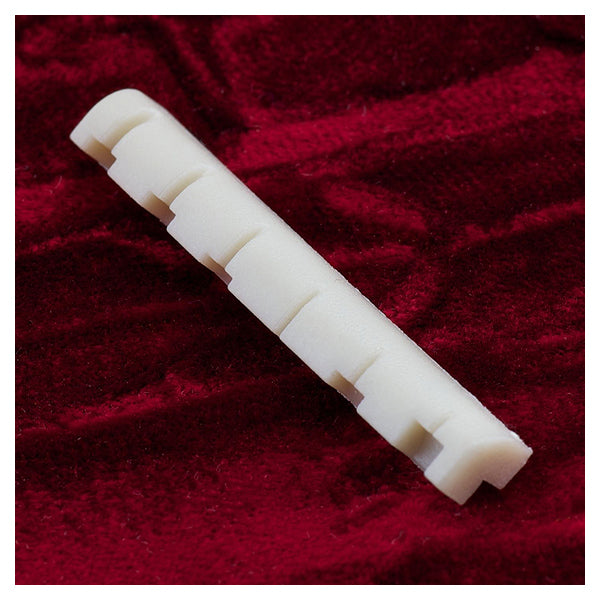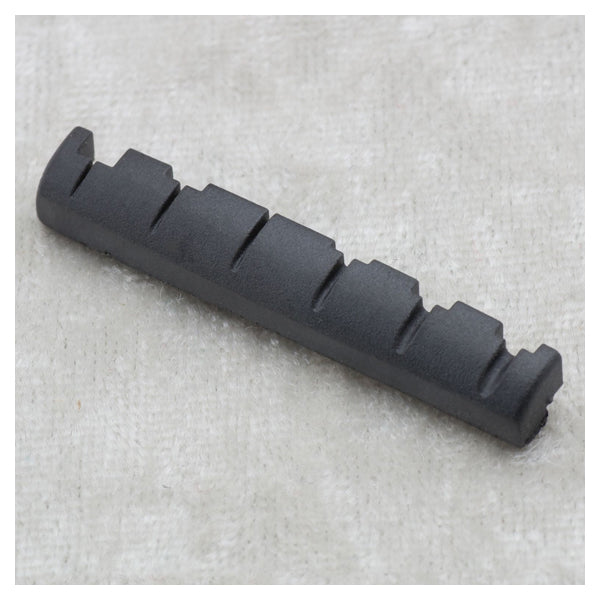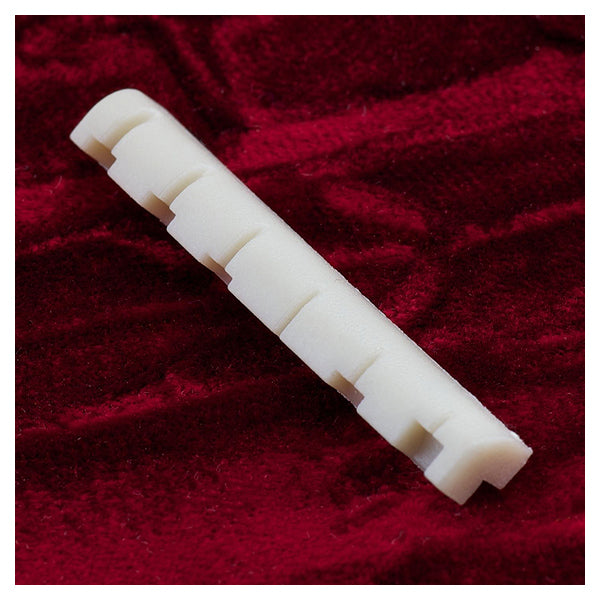earvana
Earvana Compensated Nut – Fender SHELF TYPE 12" radius
Earvana Compensated Nut – Fender SHELF TYPE 12" radius
Couldn't load pickup availability
You have probably noticed that it is nearly impossible to tune your guitar so that the chords in the first 5 frets ring true for any open chords.
Earvana has solved this problem by developing a nut that compensates for the errors that are inherent in 99% of all stringed instruments.
What makes Earvana so special?
Over many years of research and development, Earvana has designed the compensated nut to provide the most accurate intonation available on the market today.
We have perfected the correct degree of compensation at the nut and the bridge needed to achieve a total balance throughout the entire fret board. This results in string compression whereby extending the break off point at the nut flattens the intervals from the nut to the 12th fret.
By moving the bridge forward, which sharpens the intervals from the bridge to the 12th fret. This is where the comparison to tuning like a piano comes in. Lower notes on a piano are flattened progressively more from middle C to the lower register, and sharpened progressively more from middle C to the higher register.

This system of tuning is built into the Earvana nut.
Benefits
- Compensates each string individually
- No permanent modification to your guitar – perfect for vintage guitars
- No special tuners needed
- Adapts to any fretboard radius, fret size and string gauge
- Affordable so that you can outfit your entire collection
- Most accurate tuning system available
Standard Tuning vs Earvana
The two tables below show the pitch differences between a guitar with a typical nut and one fitted with an Earvana. The RED numbers are cents sharp and the BLUE numbers are cents flat. This test was conducted using a Peterson 490-ST Strobe Tuner at C 440 Hertz
Typical Nut pitch measurements (cents)

Earvana pitch measurements (cents)

An in-depth 'how it works'...
Technical Rational of How Compensation at the Nut works:
String Mass, Tension, Pitch and Equal Temperament
"Our nut is designed around equal temperament. You must accept this compromise because the guitar is an instrument of fixed pitch and the strings must be tuned to the tempered intervals, not pure. Guitarists who have been trying to tune to one or another pure chord forms must learn to understand and accept equal temperament. An interesting note to know is that to approximate pure chords on all forms would require about three dozen frets within the octave. The system of equal temperament reduces the number to twelve frets."
Rick, Earvana Creator and Patent Holder

When a guitar refuses to play in tune, fret spacing is the first thing that needs to be checked. Assuming fret spacing is correct, the second important variable affecting intonation is the stretching of the string, which occurs when a note is fretted. This stretching increases the total length of the string, which increase the tension on the string, and therefore causes the note to play sharp.
Each string behaves differently with regard to sharpening tendency when fretted. There are three related rules which apply here: 1) sharpening from fretting is inversely proportional to pitch (The Pitch Rule). 2) Pitch is proportional to string tension (The Tension Rule); and 3) String tension is proportional to string mass (The String Mass Rule).
The pitch rule tells us that a guitar will display a global tendency to more sharpness as the open string pitch goes down, and the low E string does in fact go sharp more then the high E string. However, the tension rule and the string mass rule also come into play, and we see this especially when we compare the sharpening behavior of the G and D strings. If we were to apply the pitch rule only to G and D, we would expect more sharpening for D then from G. But D in fact sharpens less then G. This is because of the metal winding on D which adds mass. Even though D is lower in pitch than G, it has a higher tension than G and therefore sharpens less. If you want to test this, you can tune your unwound G-string down to D, the string will now sharpen more when fretted at the nut than when it was tuned to G.
We can rectify the tendency to sharpness from fretting by adjusting the total length of the string from string length, and how much adjustment do we make?
To answer these questions, we need to first examine in more detail what happens when a note is fretted. The first component of stretching occurs when the string travels to the crown of the fret ("travel stretch"). However, when a guitarist frets a note, the finger isn't pressed directly down on the fret itself, instead, the finger is pressed down behind the fret, and more pressure is applied to make sure a firm string-to-fret contact is established in order to avoid buzzing. This causes additional stretching ("fretting stretch"). Each of these string stretch components must be addressed at the appropriate end of the string for best intonation results.
The correct place to compensate for travel stretch is at the saddle. By setting the saddle itself back and / or by moving the string break-off point back, thereby adding to string length. The reason for this has to do with the relationship between the amount of stretch and the ratio of compression to active string length. As we fret the string on succeeding higher frets, the total string length when fretted, and this the string tension increases because of the slope of the fingerboard with reference to the open string. Why then, doesn't each succeeding note get sharper? Because at the same time, the ratio of the compensation at the saddle to the active string length is increasing proportionally.
The correct place to compensate for fretting stretch is at the nut, by setting the string break-off point forward, which reduces the distance to the fret and thereby takes away sharpness caused by stretching. The reason for this has to do with the relationship between the ration of fretting stretch and the ration of the nut compensation to inactive string length. As notes are fretted higher on the fingerboard, the ratio of fretting stretch decreases because of the fingerboard slope. At the same time, however, the ratio of nut compensation to inactive string length is decreasing proportionally.
Compensation at the nut is correct when any note on the fingerboard fretted normally, as when playing the guitar, plays in tune. Adding complementary compensation at the nut, distributes the intonation improvement over the entire fingerboard.
The EARVANA NUT will enable a guitar to sound any note in tune anywhere on the fingerboard; assuming the open strings are properly tuned. The guitar will now function accurately as an equal-tempered instrument. For the guitar to function as a well-tempered instrument, however, requires the player's skills in proper tuning of the instrument.
It is well known that equal temperament is deficient because of anomalies is harmonicity which show up especially when cords are played. By careful tuning, the guitarist can restore harmonicity by tuning in small compromises in equal temperament. In this respect, the guitar is different from say, a piano, where the technician can tune each note individually and thus tune the piano in to a well-tempered instrument independent of the player.The EARVANA tuning system optimizes the guitars harmonicity at any position on the fingerboard, not just at the positions where chords are played to tune guitar.
Share



